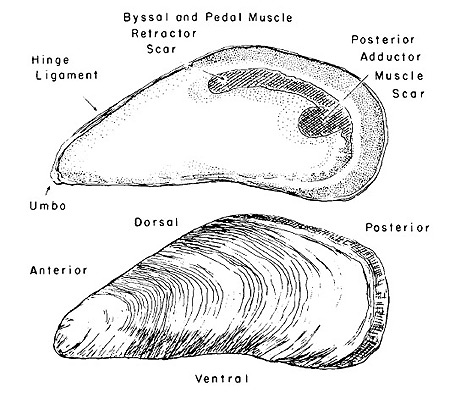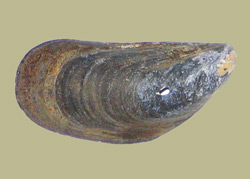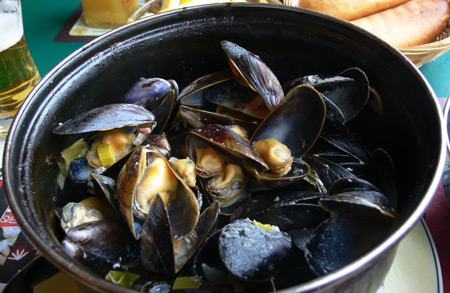A purple, blue or occasionally brown outer shell with an interior having a border of dark blue to violet surrounding a pearly white interior. The shell is smooth but typically has some growth lines. The shape is roughly an elongate triangle, up to 4 in (10 cm) at its widest dimension.

A line drawing showing the parts of a Mytilus edulis shell
The blue mussel is a widely distributed and locally abundant bivalve mollusk found in the North and Mid-Atlantic regions. It is a semi-sessile species, anchored by byssus threads to firm surfaces in littoral and sub-littoral environments. Active suspension feeders, blue mussels derive their nutrition by filtering organic particles from the water column. The dominant food source for all their life stages is phytoplankton.
The geographical range of the species is limited by lethal water temperatures above 27 C in the south and by temperatures too low for growth and reproduction in the north. Larval and adult blue mussels are important prey items for many animals, including crabs, fishes, and birds.

The exterior of a blue mussel shell
In sheltered environments, large aggregations of mussels sometimes form dense beds that provide shelter for a variety of other invertebrates. In both these sheltered environments and exposed shores, blue mussel clumps sometimes become so thick that relatively few individuals are attached to the firm substrate. In such situations, storms occasionally wash away large sections of the mussel bed.
The blue mussel is diecious and oviparous. Eggs and gametes are released into the water column, where fertilization occurs. The timing of reproduction is dependent on local conditions that include nutrient availability and temperature. The planktotrophic larvae take about 3 weeks to develop and metamorphose. The juveniles grow to approximately 1.5 mm while attached to filamentous algae that are attached to a substrate. Then they are carried by water currents to a new location where they reattach to a firm substrate. This substrate may vary from large boulders to pebbles or, very frequently, other mussel shells.
North Atlantic, Europe and other temperate and polar marine areas.
The blue mussel is a common item on seafood restaurant menus throughout the United States. In Canada and Europe the blue mussel is considered a quality seafood product and in Spain, France, Holland, and Italy, it forms the basis of an extensive commercial mariculture.

Blue mussels are on many menus.
Macroparasitic pea crabs can infest live mussels, living firmly attached by their rear legs to the gill of the bivalve. The crab feeds on food particles traveling in the food grooves and can cause severe gill damage.
Blue mussels tolerate low temperatures for extended periods, even surviving being frozen in ice for up to 8 months each year in Labrador populations.
